
Please scroll down for English.
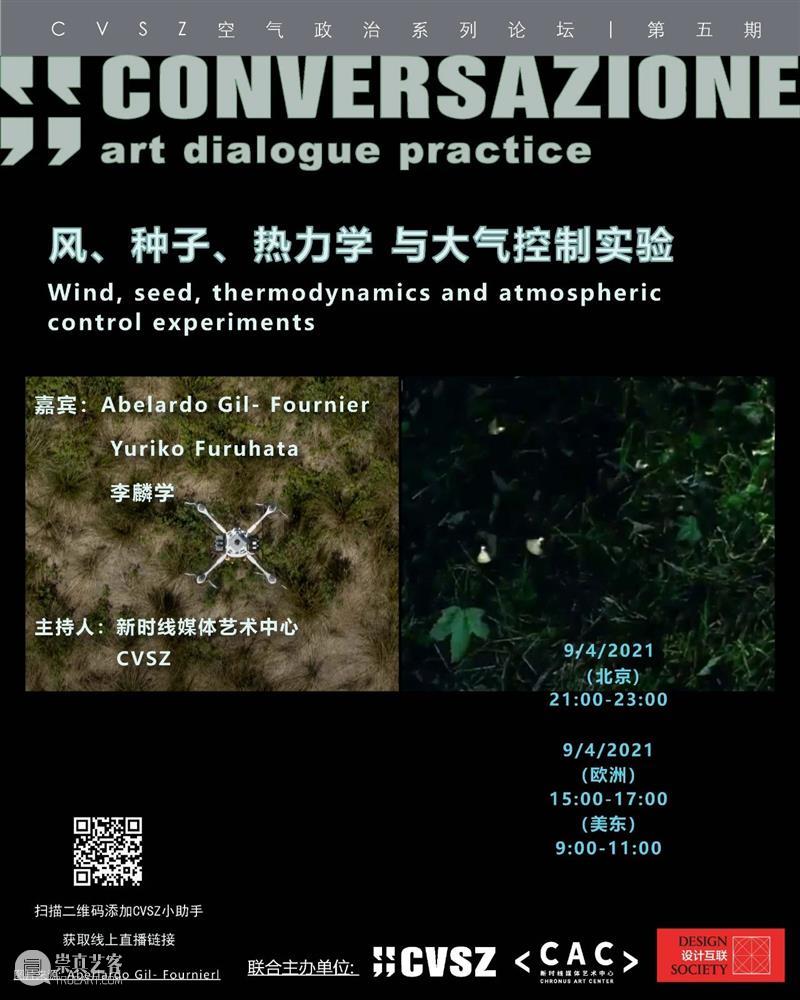
日期: 2021.09.04(周六) 时间: 21:00 - 23:00 导师: 阿韦拉多·吉尔-福尼尔(Abelardo Gil-Fournier)、古畑百合子(Yuriko Furuhata)、李麟学 语言: 中文/英文 主办: 新时线媒体艺术中心、CVSZ、设计互联
讲座形式:
Zoom
https://zoom.com.cn/j/6761556786
会议ID: 676 155 6786
近年来,越来越多的科学家、工程师、艺术家聚焦于自然界中的风、种子和大气环境和进行大气控制实验。对媒介环境学的研究逐渐脱离了传统的以多伦多传播研究学院和马歇尔·麦克卢汉(Marshall McLuhan)为代表的“媒介即是环境(media as environments)”的生态框架,进而转变为对自然环境化的技术媒介(technical media that become environmental)实现更物质化、底层化和系统化的研究。
阿韦拉多·吉尔-福尼尔(Abelardo Gil-Fournier)与杰西·帕瑞卡(Jussi Parrika)合作的散文电影《种子、图像与土地》(Seed, Image and Ground)抛出了这样一个问题:风如何转化为图像?由直升飞机制造的人造风代替了自然风,吹拂地球表面,影响了气象的制造、农作方式以及人类对植物、空中作业和土地的认知转变。地球表面被空中应用技术捕捉并转化为数据图像。它们从地面展现了大气形态,从空中显示地表形态,将植被描绘为图像,并用图像来定义土地的形态。这样大规模对风与大气进行视觉化和图像化的处理,隐射了怎样的技术逻辑与文化?
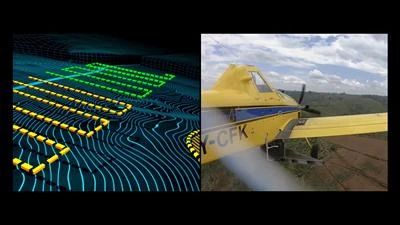
艺术史与媒体史学者古畑百合子(Yuriko Furuhata)在《气候媒体:大气控制中的跨太平洋实验》(Climatic Media: Transpacific Experiments in Atmospheric Control )一书中指出,无论对大气进行何种方式的控制,大气工程的建设都逃不开人类对于生存空间安全性的考量——从军事中的应用,到平民生活中确保食物和水的安全,再至大气控制与二十世纪的地缘和生物政治,这一切皆息息相关。大气变化所造成的不安全感,也是现代性技术发展的必然规律。人们通过研发更多技术去克服技术所引发的焦虑,例如发明防毒面具、空气净化器等等,然而也因此陷入了一个持续恐惧的死循环。
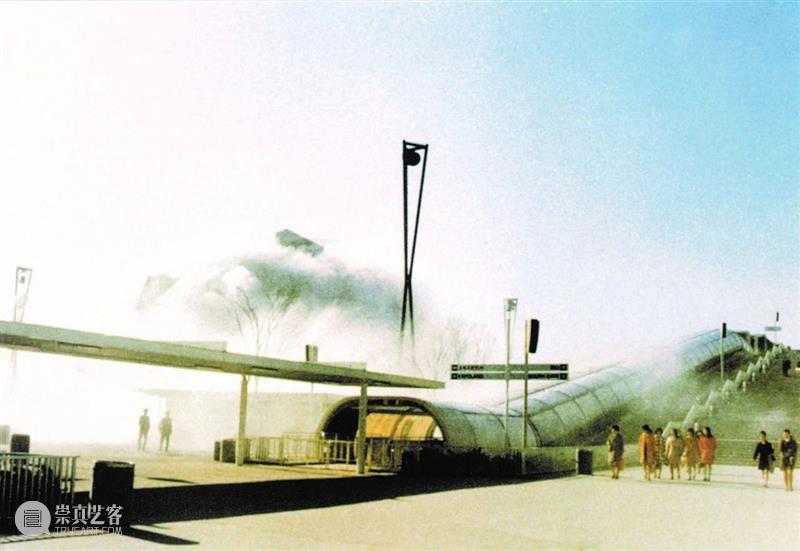
当现代建筑室内引入了冰箱、空调、加湿器等微气候调节装置,人们实现了对空气温度、湿度、成分的主动调控。当建筑内部与外界环境隔离,封闭的建筑系统也成为了大量能源消耗和环境危机的诱因。同时,建筑本身丰富的建构逻辑也因这些内环境调节装置面临着同质化的问题。在热力学建筑体系中,物质、能量、气候、形式、身体和系统形成了能量桥梁,不断交互。同济大学建筑与城市规划学院的李麟学教授将建筑中的能量流动机理总结为“能量捕获”、“能量协同”与“能量引导”的过程。于是,能量在气候环境、建筑系统和人的身体之间流动与转化。正如美国建筑理论家萨拉·怀汀(Sarah Whiting)所讲:“将热力学定律应用于建筑领域,‘空气’便成为空间组织的主角;建筑可理解为一种物质的组织,并由这种组织带来 ‘能量流动’的秩序,同时平衡与维持建筑的‘物质形式’”。热力学建筑又如何在现代中国的背景下进行实践?
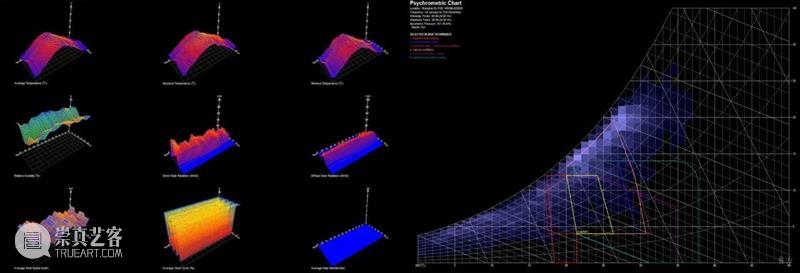
在本次讲座中,三位嘉宾将从各自的研究视角出发,分析人类工业文明和殖民历史中对于陆地、海洋、天空持续性的气象改造,并批判性地回应人类对生活在"可控气候环境“中的渴望与生存空间的不断开拓。
< 嘉宾介绍 >
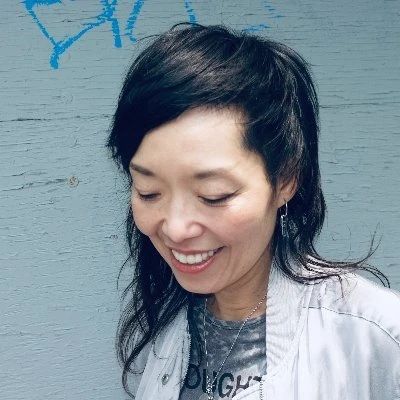
古畑百合子(Yuriko Furuhata),麦吉尔大学东亚研究,艺术史与传播研究和世界电影项目副教授。百合子的新书《气候媒体:大气控制中的跨太平洋实验》(Climatic Media: Transpacific Experiments in Atmospheric Control )追溯了从 20 世纪初到现在的气候工程,强调了日本帝国建设的遗产及其与美国冷战时期的联盟。百合子 扩大了媒介研究的范围,考虑化学“调节”地球大气和社会“调节”人们行为的技术。她通过研究一系列技术,如云播种和人造雪、用于天气预报和天气控制的数字计算、用于城市规划和警务的控制论、Nakaya Fujiko的雾雕塑以及Tange Lab 和 Metabolists 的建筑实验,跨太平洋分析地媒介与气候变化的历史。
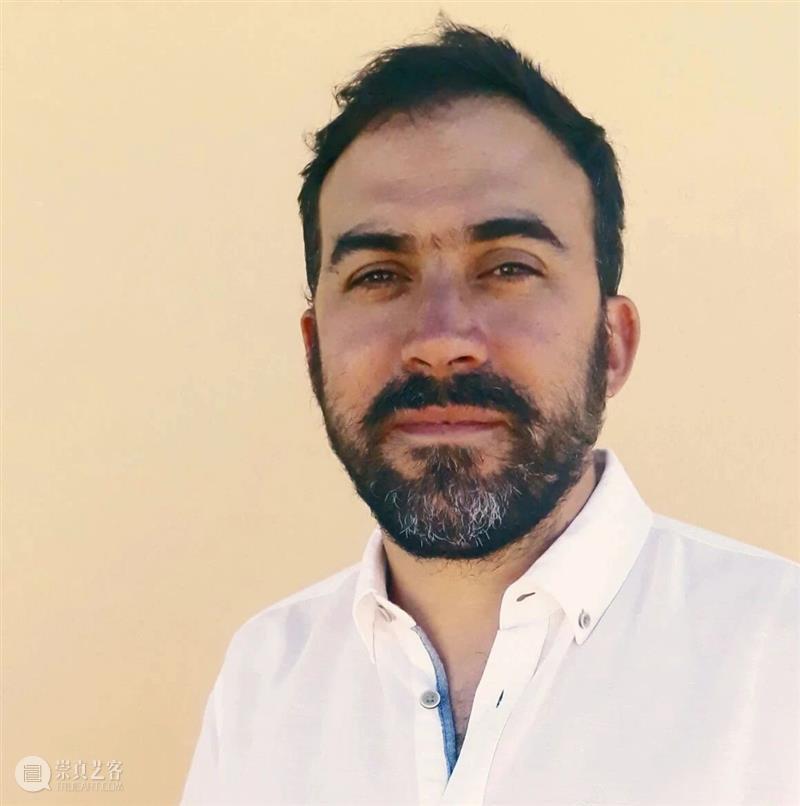
阿韦拉多·吉尔-福尼尔(Abelardo Gil-Fournier),艺术家、研究者,其工作探讨了当代图像与行星活动表面之间的关系。吉尔-福尼尔拥有温彻斯特艺术学院的博士学位,目前是布拉格FAMU的博士后研究员,是AMT(媒体与技术考古学)研究组织成员,也是马德里欧洲大学的兼职讲师。他的实践基于对平台(装置,设备和工作室)的精心设计。这些平台被视为有开放机制,呈现了艺术,知识和政治的相交。
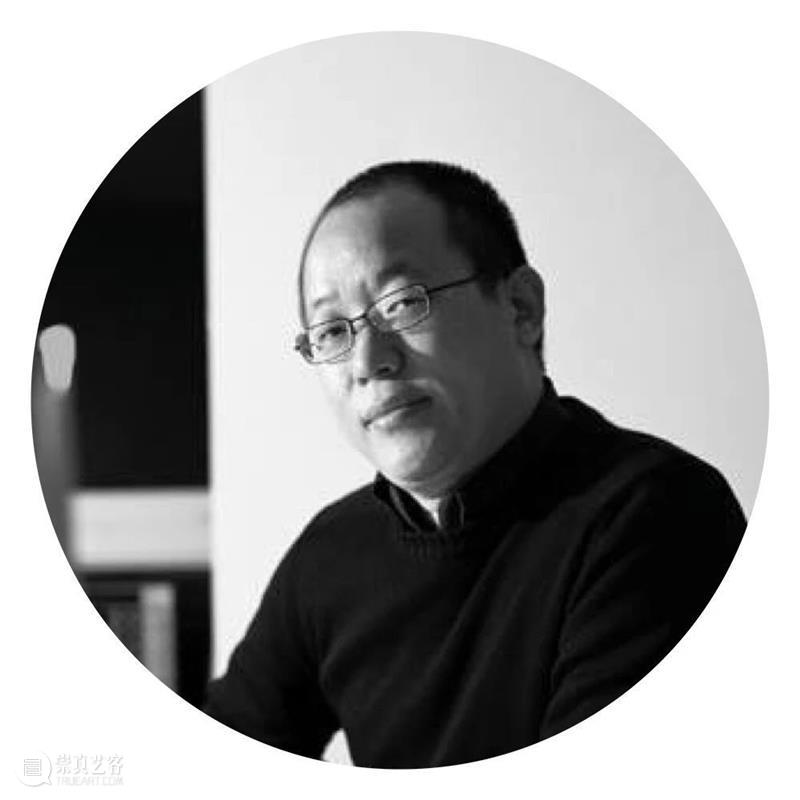
李麟学,同济大学建筑与城市规划学院教授,博士生导师;同济大学艺术与传媒学院院长;同济大学麟和建筑工作室ATELIER L+ 主持建筑师, 《时代建筑》专栏主持人,哈佛大学GSD设计研究生院高级访问学者(2014),谢菲尔德大学建筑学院Graham Wills访问教授(2020-2022)。2000年曾入选法国总统交流项目“50位建筑师在法国”(50 ARCHITECTES EN FRANCE),在巴黎建筑学院PARIS-BELLEVILLE学习交流。李麟学试图以明确的理论话语,确立建筑教学、研究、实践与国际交流的基础,将建筑学领域的“知识生产”与“建筑生产”贯通一体。主要的研究领域包括:热力学生态建筑、公共建筑集群、以及当代建筑实践前沿等。
< 联合主办 >
CAC × CVSZ
Wind, Seed, Thermodynamics and Atmospheric Control Experiments
Date: 2021.09.04(Saturday) Time: 21:00 - 23:00
Guests: Abelardo Gil-Fournier, Yuriko Furuhata, LILinxue Language: Chinese/English Co-organized by
Chronus Art Center, CVSZ, The Design Society
Event on Zoom https://zoom.com.cn/j/6761556786
Meeting ID: 676 155 6786
In recent years, an increasing number of scientists, engineers and artists have drawn attention to the wind, seeds, atmospheric environments and experiments of the natural world. The study of media ecology is moving away from the traditional ecological framework underpinned by the Toronto School of Communication and the concept 'media as environments' represented by Marshall McLuhan. This has led to a more materialized, fundamental and systematic study of technological media that become environmental.
The essay film Seed, Image and Ground by Abelardo Gil-Fournier and Jussi Parrika poses a question: how does wind become an image? The gusts created by a helicopter substituted for natural winds blow across earth's surface, influencing weather production, farming operations and transformation of human apprehension of plants, aerial operations and land. Earth's surface is captured and transformed into data images by aerial application technologies. They present atmospheric patterns from the ground, embody planetary surface patterns in the cloud, portray vegetation as images and use images to define the land. What kind of technological logic and culture is demonstrated by such large-scale visualization and imaginization of wind and atmosphere?
In her book Climatic Media: Transpacific Experiments in Atmospheric Control, art and media historian Yuriko Furuhata argues that, regardless of its applications, atmosphere engineering develops in a way inseparable from the question of security of our living space. From its military application, to its civilian application that ensured food and water security, atmospheric control closely entwined with the geopolitics and biopolitics of the twentieth century. The sense of insecurity posed by atmosphere modification is a rule for the advancement of modern technology. People attempt to overcome the anxiety caused by technology via the innovation of technology, such as gas masks, air purifiers, etc., but this also led to a vicious cycle of constant phobia.
The utilization of microclimate control appliances such as refrigerators, air conditioners and humidifiers in modern architecture allows proactive manipulation of air temperature, humidity and composition. When the building interior is isolated from the external environment, the closed indoor system also becomes a cause of massive energy consumption and environmental crisis. At the same time, the rich constructive logic of architecture per se encounters the problem of homogenization due to the insertion of indoor climate control appliances. In the system of thermodynamic architecture, substance, energy, climate, form, body and system bridge each other and constantly interact. Professor Li Linxue from the College of Architecture and Urban Planning in Tongji University summarizes the mechanism of energy flow in architecture as a process of 'energy capturing', 'energy synergy' and 'energy steering'. Thus, energy flows and transforms among climate, architecture system and the human body. As the American architectural theorist Sarah Whiting pointed out, air becomes the protagonist of the spatial organization in thermodynamic architecture, balancing and maintaining the energy flow of the architecture as a form of material reality. How can thermodynamic architecture be actualized in the context of modern China?
In this talk, the three guests will analyze the continuous climate modification of land, sea and sky in the industrial and colonial history of mankind from their own research perspectives, and critically respond to human desire to live in a 'controlled climate' and the relentless exploration of living space.
< About the Guests >

Yuriko Furuhata, Associate Professor & William Dawson Scholar of Cinema and Media History in the Departments of East Asian Studies & Art History and Communication Studies and World Cinemas Program at McGill University. Her book Climatic Media: Transpacific Experiments in Atmospheric Control traces the technological, institutional, and geopolitical connections between Japan and the United States that led to the historical development of artificial fog, weather control, cybernetic environments, metabolic architecture, and networked computing in the 20th century. Furuhata extends the scope of media research in consideration of the technology applied for chemical modification of earth weather and social modification of people's behaviour. She investigates a series of technologies such as cloud seeding, artificial snow, computing for weather forecasting and control, cybernetics of urban planning and policing, Nakaya Fujiko's fog installations and the architecture experiments by Tange Lab and Metabolists in a bid to examine the history of transpacific GeoMedia and climate change.

Abelardo Gil-Fournier is an artist and researcher. His practice addresses the entwining of image surfaces with the living crust of the planet. Fournier holds a PhD in Arts from the Winchester School of Art (UK), currently works at FAMU Prague (Czech Republic) as part of the project Operational Images and Visual Culture and is a member of AMT Archaeologies of Media and Technology. His works are based on the dexterous design of platforms (installations, appliances and studio) which are considered as open mechanisms for the intersection of art, episteme and politics.

LI Linxue, Prof. Dr. Linxue Li is a professor and Ph. D Supervisor at College of Architecture and Urban Planning,and the dean of College of Arts and Media of Tongji University,principal architect of ATELIER L+,chairman of special column in T+A, visiting scholar at Graduate School of Design Harvard University in 2014,and Graham Wills Visiting Professor of School of Architecture at University of Sheffield from 2020 to 2022. In 2000, he was selected by the Presidential Program “50 ARCHITECTES EN FRANCE” and studied in Ecole d'Architecture de Paris-Belleville. Linxue Li tries to establish his architectural teaching, research, practice and international exchange based on thedefinite theoretical discourse and to integrate the production of knowledge and production of buildings in the field of architecture. His main fields of researches include thermodynamic ecological architecture, public architectural conglomerate, and frontier for contemporary architectural practice ect..
< Co-organized with >


新时线媒体艺术中心(CAC)成立于2013年,系国内首家致力于媒体艺术之展示、研究/创作及学术交流的非营利性艺术机构。通过展览、驻留、奖学金、讲座、工作坊及相关文献的梳理与出版,CAC为媒体艺术在全球语境中的论述、生产及传播开拓了一个多样化且富有活力的平台。CAC以批判地介入不断改变进而重塑当代经验的媒体技术来推动艺术创新及文化认知。
Established in 2013, Chronus Art Center (CAC) is China’s first nonprofit art organization dedicated to the presentation, research / creation and scholarship of media art. CAC with its exhibitions, residency-oriented fellowships, lectures and workshop programs and through its archiving and publishing initiatives, creates a multifaceted and vibrant platform for the discourse, production and dissemination of media art in a global context. CAC is positioned to advance artistic innovation and cultural awareness by critically engaging with media technologies that are transforming and reshaping contemporary experiences.
www.chronusartcenter.org
更多展览以及艺术家信息请持续关注新时线媒体艺术中心微信公众号动态.
媒体垂询:media@chronusartcenter.org
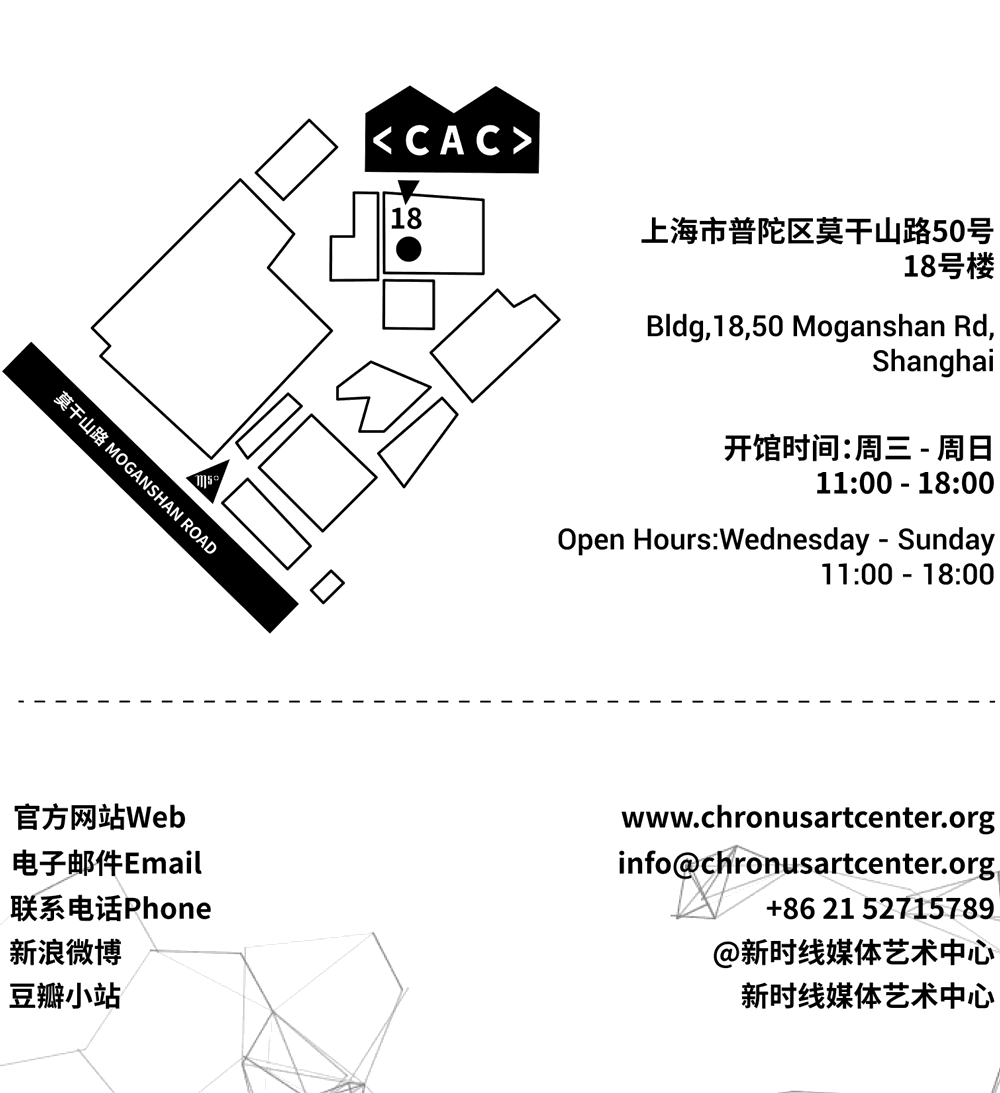


已展示全部
更多功能等你开启...
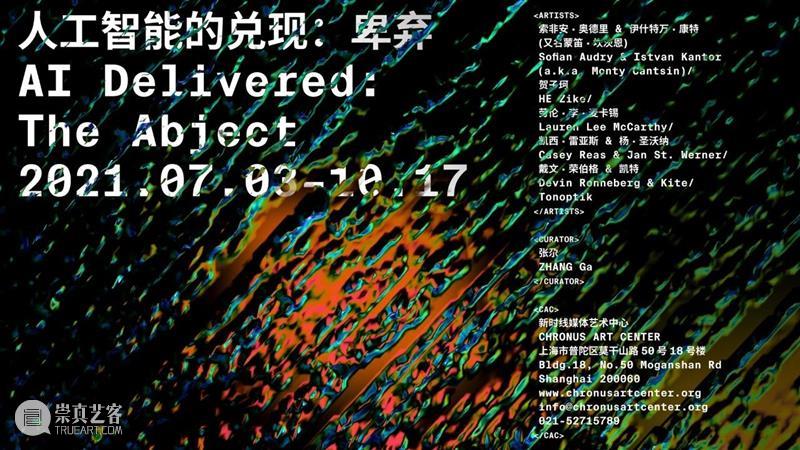





 分享
分享